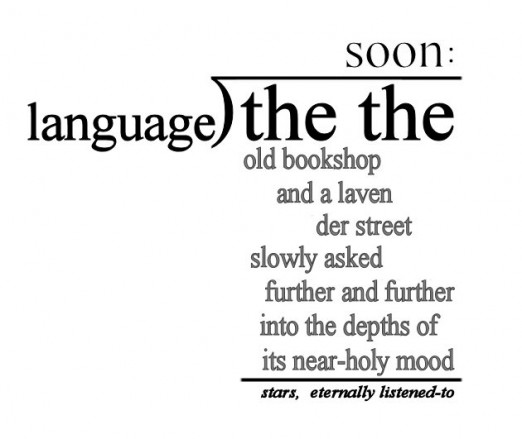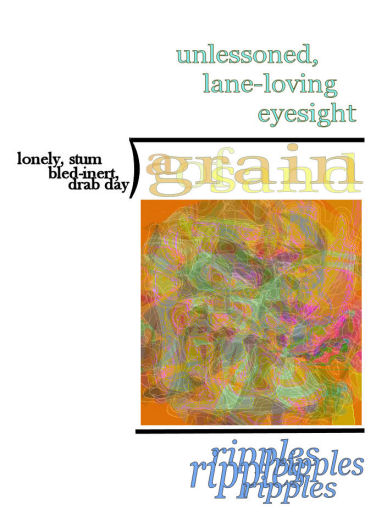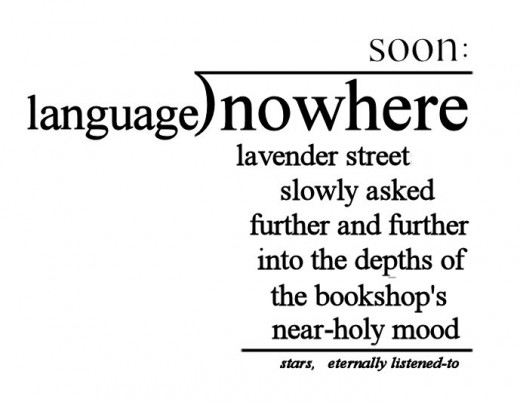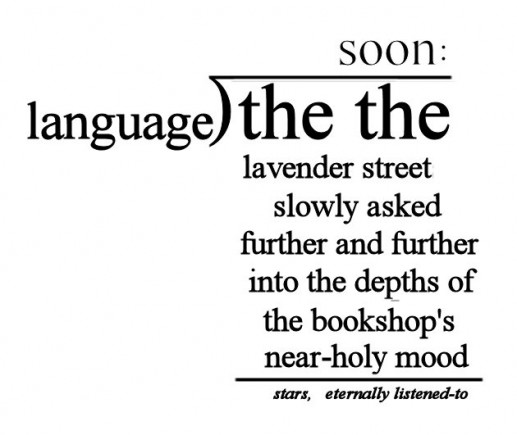Entry 369 — A Discussion of the Pluraphrase
In his kind blog entry on me the other day, Geof Huth pointed out a difference between the two of us that got me thinking. It was that I need to know the meaning of each of my poems, whereas he doesn’t mind not knowing what a particular poem of his means, and sometimes doesn’t. As is often the case, he was half right. Certainly, I have a greater need to know the meaning of my poems than he has to know the meaning of his. Never do I expect fully to know the meaning of a poem of mine, however. Indeed, if I too quickly maxolutely grasp a poem’s meaning, I feel pretty certain it isn’t very good.
If by “understanding the meaning” we mean understanding the verbal meaning. I mean far more than that by the term, though, for one can have only a very hazy verbal understanding of some poems but a visceral understanding of them that more than makes up for it. Which I suspect Geof needs. Does a poem make sense as an arrangement of elements? Does it sound or look aesthetically pleasing in some important manner?
Zogwog. I played tennis this morning. On the way back on my bike I thought of how I was going to soar through this entry. I had what I was going to say all figured out. The result would be a description of something I call “the pluraphrase,” that I came up with twenty years or so ago. It’s basically an analysis of a poem so full that, if carried out with skill, should permanently nail a poem. I think no poem can be considered effective if no one can come up with a pluraphrase of it a reasonable number of others agree is sound and reasonably complete. Effective as a poem, I mean.
For some reason, I’m swigging every whose where, not sure why. Will try to get a grip on mineself and concentrate.
First there’s the paraphrase, which is a summary of what the poem’s words and graphics, if any, mainly denote, connote and clearly allude to via quotations, symbols or other “advertances,” as I call them. If you can’t make one for a given poem, either you or it is defective. But there is much more to a poem than what a paraphrase tells you about it.
One thing is what a close reading uncovers. Which should be everything a poem’s words and graphics, if any, denote, connote and allude to.
Finally, and in my view most important, is the pluraphrase. That’s the close reading plus the . . . technalysis, my new-today term for an analysis of what a poem does technically. To wit: its melodation, or everything regarding what it does with sound–rhyme, meter, auditory shaping–and anything that contributes to the poem’s connotational or allusional ability (which can be great–for instance, what the sonnet-shape does as an advertance to the history of the sonnet in the West); its visio-aesthetic effects, or what its visual elements beyond the conventional shape of its letters, punctuation marks and other textemes do for it decoratively or visiopoetically; its audio-aesthetic effects, or what its auditory elements beyond the conventional sound of its syllables do for it decoratively or beyond that to make it a sound poem, if that’s what it is; its linguitechnics or its appropriate misuse of grammar for aesthetically meaningful language poetry effects; its freshification (I know, I need a better term for this, but I’m ad hoccing at the moment), which in conventional poetry is primarily its use of fresh diction or subject matter–particularly in the case of surrealistic and jump-cut poetry, of fresh juxtapositions of images; mathaesthetic effects, or the use of mathematical operations on non-mathematical terms as in my mathemaku; miscaesthetic (miscellaneous aesthetic) effects or the contribution of its gustatory, olfactory, tactile, or the like in some aesthetically meaningful way.
No doubt there are elements of poetry I’ve overlooked. Let me know about them, please. I truly want to be complete.
My view, as stated, is that no poem that cannot be given a reasonably full and coherent pluraphrase can be effective. My only evaluative uncertainty is whether or not a poem for which no reasonably full and coherent close reading exists can be considered effective–as a poem. Such a text may prove sufficiently audio-aesthetically or visio-aesthetically pleasing to be considered effective as music (textual music) or visimagery (textual visimagery), but not as poetry, which needs to be verbo-aesthetically compelling to qualify as an effective poem. For instance, Gertrude Stein’s buttons, which are not poems but short pieces of evocature, would be effective as prose if they could be shown to make verbal sense. Stephen-Paul Martin did that for one of them to my satisfaction in a book whose title escapes me, and someone else did the same for another, I vaguely recall. Marjory Perloff failed to do it for a number of them. As is, the most you can say for them is that they may be somewhat effective pieces of music.
Getting back to how much a poet should know about his own poems, I don’t think he ought to make a pluraphrase of everyone of them. I haven’t of mine. But he ought to have some feel for whether a poem of his could be pluraphrased, and whether at least some of its elements were superior. I’m sure that most poets know these things in some way. Sometimes intense analysis is necessary, I think. Unless a single pleasing effect is enough for you, and you don’t care about the unifying principle I believe every poem needs to make it to the top.
My temperament is such that I enjoy analysis. I find it almost always useful. True, sometimes one’s analysis can lead one astry. More often it helps, I believe. I now believe it has with regard to the mathemaku Geof posted of mine in his little celebration of my birthday the other day. The version he posted almost convinced me I should have “soon:” as its quotient instead of “Persephone.” Last night, thanks to analysis, to trying to fathom the full meaning of the poem, I concluded I was wrong. “Persephone” is definitely better. The quotient times “mystery” is supposed to equal the springlike effect of language on the world, according to my analysis, so multiplying it by “Persephone,” the goddess of spring, will clearly allow this while multiplying it by “soon:” will not clearly do it. The idea of soon something will follow won’t suggest it to many, I don’t think. And although I tried hard to think of how language could be thought to have anything to do with “soonness,” I couldn’t. Nor did mystery. If it had, then “soon:” wouldn’t have had to. “Persephone” may be a tick too overt, but I’d rather be too clear than unclear. Besides, it’s “Persephone” in its sole hard copy publication.
* * *
On my bike, I imagined I’d be able to make this entry a wonderful source for students of poetry that no college could be without. It didn’t work out that way. I do hope to return to it sometime and improve it.




“My view, as stated, is that no poem that cannot be given a reasonably full and coherent pluraphrase can be effective.”
Bob, can you pick, say, a sonnet by Shakespeare or Petrarch or Hopkins and offer “a reasonably full and coherent pluraphrase” for it? Let’s flesh out this terminology a little bit.
Good idea, Conrad. In fact, a while ago I started a book on Shakespeare’s Sonnet 18. A book. My goal was something quite a bit more than “a reasonably full and coherent pluraphrase.” For instance, I listed every instance of alliteration, assonance, rhyme, consonance and euphony in it.
A good pluraphrase would be very boring to read. The practical critic basically carries out a good enough substitute for one by clicking off what a poem mainly says, how it says it and what’s good and bad about it.
To give a good example of a pluraphrase, I think I’d do one of a haiku. If I ever do a full essay on it, I guess I’ll have to do one of something standard, probably Sonnet 18. Maybe not, on second thought, because my take on that is non-conformist and would need justification. (I consider it primarily a celebration of summer.) Better that I choose something I can interpret conventionally. I’ll think about it. But remember that I’m very lazy.
I think some of what I said about it that qualifies as pluraphrasial is here at my blog, findable with a search, maybe even using tags. Or it may be at my previous blog. I’ll check.
Sorry, just one entry here, a short one. You’ll have to wait, I guess.
–Bob